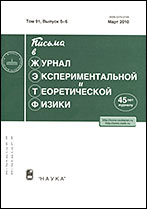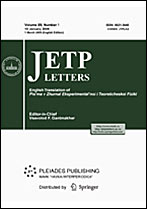|
Эта публикация цитируется в 45 научных статьях (всего в 45 статьях)
АСТРОФИЗИКА И КОСМОЛОГИЯ
Breaks in gamma-ray spectra of distant blazars and
transparency of the Universe
G. I. Rubtsov, S. V. Troitskii
Institute for Nuclear Research, Russian Academy of Sciences, Moscow
Аннотация:
Energetic gamma rays scatter on soft background radiation when propagating
through the Universe, producing electron-positron pairs
(A. I. Nikishov, Sov. Phys. JETP 14, 393 (1962)).
Gamma rays with energies between $100$ GeV and a few TeV interact mostly
with infrared background photons whose amount is poorly known
experimentally but safely constrained from below by account of the
contribution of observed light from known
galaxies (R. C. Keenan, A. J. Barger, L. L. Cowie, and W.-H. Wang,
Astrophys. J. 723, 40 (2010); arXiv:1102.2428).
The expected opacity of the intergalactic
space limits the mean free path of TeV gamma rays to dozens of
Megaparsecs. However, TeV photons from numerous more distant sources have
been detected (S. P. Wakely and D. Horan, http://tevcat.uchicago.edu).
This might be interpreted, in each
particular case, in terms of hardening of the emitted spectrum caused by
presently unknown mechanisms at work in the sources
(S. Archambault et al. (VERITAS and Fermi LAT Collaborations),
Astrophys. J. 785, L16 (2014); arXiv:1403.4308).
Here we show that this interpretation is not supported by the analysis of the
ensemble of all observed sources. In the frameworks of an
infrared-background model with the lowest opacity
(R. C. Gilmore, R. S. Somerville, J. R. Primack, and A. Dominguez,
Mon. Not. Roy. Astron. Soc. 422, 3189 (2012); arXiv:1104.0671),
we reconstruct the emitted spectra of distant blazars and find
that upward spectral breaks appear precisely at those energies where
absorption effects are essential. Since these energies are very different
for similar sources located at various distances, we conclude that the
breaks are artefacts of the incorrect account of absorption and,
therefore, the opacity of the Universe for gamma rays is overestimated
even in the most conservative model. This implies that some novel physical
or astrophysical phenomena should affect long-distance propagation of
gamma rays. A scenario in which a part of energetic photons is converted
to an inert new particle in the vicinity of the source and reconverts back
close to the observer
(M. Simet, D. Hooper, and P. Serpico,
Phys. Rev. D 77, 063001 (2008); arXiv:0712.2825;
M. Fairbairn, T. Rashba, and S. Troitsky,
Phys. Rev. D 84, 125019 (2011); arXiv:0901.4085)
does not contradict to our
results. This new axion-like particle appears in several extensions of the
Standard Model of particle physics
(J. Jaeckel and A. Ringwald,
Ann. Rev. Nucl. Part. Sci. 60, 405 (2010); arXiv:1002.0329)
and may
constitute the dark matter
(P. Arias et al., JCAP 1206, 013 (2012); arXiv:1201.5902).
Поступила в редакцию: 03.07.2014
Исправленный вариант: 13.08.2014
Образец цитирования:
G. I. Rubtsov, S. V. Troitskii, “Breaks in gamma-ray spectra of distant blazars and
transparency of the Universe”, Письма в ЖЭТФ, 100:6 (2014), 397–401; JETP Letters, 100:6 (2014), 355–359
Образцы ссылок на эту страницу:
https://www.mathnet.ru/rus/jetpl4120 https://www.mathnet.ru/rus/jetpl/v100/i6/p397
|


| Статистика просмотров: |
| Страница аннотации: | 256 | | PDF полного текста: | 63 | | Список литературы: | 54 | | Первая страница: | 2 |
|





 Обратная связь:
Обратная связь: Пользовательское соглашение
Пользовательское соглашение
 Регистрация посетителей портала
Регистрация посетителей портала Логотипы
Логотипы







 Цитирование в формате
Цитирование в формате 
